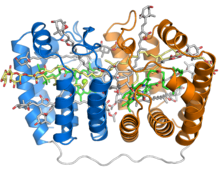Peridinin
Peridinin is a light-harvesting apocarotenoid, a pigment associated with chlorophyll and found in the peridinin-chlorophyll-protein (PCP) light-harvesting complex in dinoflagellates, best studied in Amphidinium carterae.
[1] Peridinin is an apocarotenoid pigment that some organisms use in photosynthesis.
The peridinin-chlorophyll-protein complex is a specialized molecular complex consisting of a boat-shaped protein molecule with a large central cavity that contains peridinin, chlorophyll, and lipid molecules, usually in a 4:1 ratio of peridinin to chlorophyll.
[1][2][3] Peridinin chlorophyll (PerCP) is commonly used in immunoassays such as fluorescence-activated cell sorting (FACS) and flow cytometry.
The fluorophore is covalently linked to proteins or antibodies for use in research applications.



